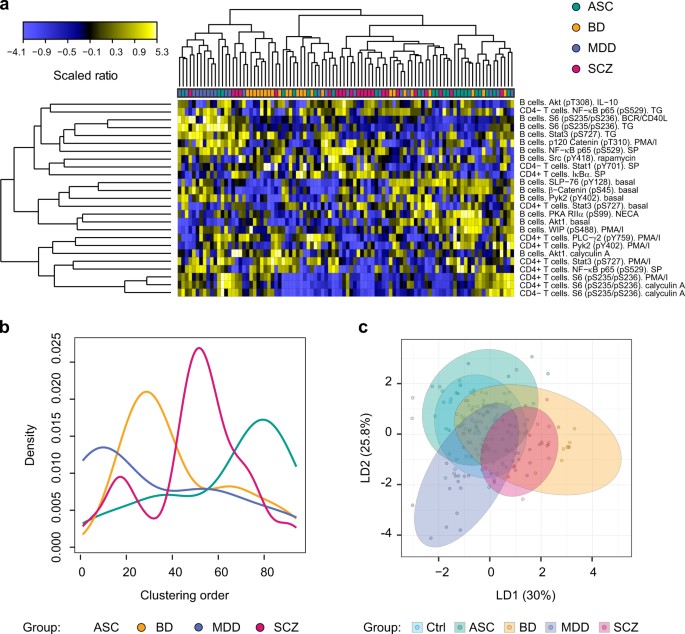Exploring the neuropsychiatric spectrum using high-content functional analysis of single-cell signaling networks
- Select a language for the TTS:
- UK English Female
- UK English Male
- US English Female
- US English Male
- Australian Female
- Australian Male
- Language selected: (auto detect) - EN

Play all audios:

Neuropsychiatric disorders overlap in symptoms and share genetic risk factors, challenging their current classification into distinct diagnostic categories. Novel cross-disorder approaches
are needed to improve our understanding of the heterogeneous nature of neuropsychiatric diseases and overcome existing bottlenecks in their diagnosis and treatment. Here we employ
high-content multi-parameter phospho-specific flow cytometry, fluorescent cell barcoding and automated sample preparation to characterize ex vivo signaling network responses (n = 1764)
measured at the single-cell level in B and T lymphocytes across patients diagnosed with four major neuropsychiatric disorders: autism spectrum condition (ASC), bipolar disorder (BD), major
depressive disorder (MDD), and schizophrenia (SCZ; n = 25 each), alongside matched healthy controls (n = 100). We identified 25 nodes (individual cell subtype–epitope–ligand combinations)
significantly altered relative to the control group, with variable overlap between different neuropsychiatric diseases and heterogeneously expressed at the level of each individual patient.
Reconstruction of the diagnostic categories from the altered nodes revealed an overlapping neuropsychiatric spectrum extending from MDD on one end, through BD and SCZ, to ASC on the other
end. Network analysis showed that although the pathway structure of the epitopes was broadly preserved across the clinical groups, there were multiple discrete alterations in network
connectivity, such as disconnections within the antigen/integrin receptor pathway and increased negative regulation within the Akt1 pathway in CD4+ T cells from ASC and SCZ patients, in
addition to increased correlation of Stat1 (pY701) and Stat5 (pY694) responses in B cells from BD and MDD patients. Our results support the “dimensional” approach to neuropsychiatric disease
classification and suggest potential novel drug targets along the neuropsychiatric spectrum.
We would like to thank clinicians and support staff at the affiliated institutions for patient recruitment and sample collection, including Liliana Ruta and Stephanie Mok for the ASC cohort;
Eva Brombacher for sample preparation; collaborators Joshua A. Bishop, Tracey Petryshen, and Steven J. Haggarty from Harvard Medical School (Boston, MA, USA) for contribution of the JB1121
compound; and PBMC donors for provision of biological samples.
This work was supported by grants to S.B. from the Stanley Medical Research Institute (SMRI) and the Engineering and Physical Sciences Research Council UK (EPSRC CASE studentship and Impact
Acceleration Award). S.G.L. was supported an by EPSRC CASE studentship and Psynova Neurotech Ltd. J.T. was supported through grants awarded t`o Psynova Neurotech Ltd. by the European Union
FP7 funding scheme: Marie Curie Actions Industry-Academia Partnerships and Pathways (ref. 286334, PSYCH-AID project); by the Virgo consortium, funded by the Dutch Government (ref. FES0908);
by the Netherlands Genomics Initiative (ref. 050-060); and by the Dutch Fund for Economic Structure Reinforcement, the NeuroBasic PharmaPhenomics project (ref. 0908). S.B.-C. and B.A. were
supported by the Autism Research Trust.
Department of Chemical Engineering and Biotechnology, University of Cambridge, Cambridge, UK
Santiago G. Lago, Jakub Tomasik, Geertje F. van Rees, Jordan M. Ramsey, Frieder Haenisch, Jason D. Cooper, Jantine A. Broek & Sabine Bahn
Department of Psychiatry, Marqués de Valdecilla University Hospital, IDIVAL, School of Medicine, University of Cantabria, Santander, Spain
Centro de Investigación Biomédica en Red de Salud Mental (CIBERSAM), Santander, Spain
Department of Psychiatry and Psychotherapy, University of Münster, Münster, Germany
Autism Research Centre, Department of Psychiatry, University of Cambridge, Cambridge, UK
Cambridgeshire and Peterborough NHS Foundation Trust, Cambridge, UK
CLASS Clinic, Cambridgeshire and Peterborough NHS Foundation Trust, Cambridge, UK
J.T. was a consultant for Psynova Neurotech Ltd. until April 2016. S.G.L. was part funded by Psynova Neurotech Ltd. until October 2015. S.B is a director of Psynova Neurotech Ltd. and
Psyomics Ltd. The remaining authors declare that they have no conflict of interest.
Anyone you share the following link with will be able to read this content: